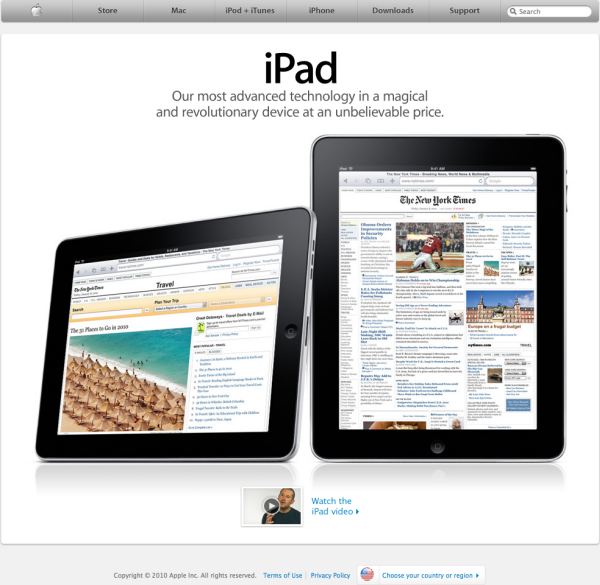Gorgeous. Awesome. Revolutionary. Yes, yes, yes… Apple’s new iPad is all of those things. Of course it is. That’s what Apple does. But iPad also means Apple has taken over the publishing industry just like they did the music industry.
iPad also means 2009 wasn’t just the year of the ebook reader. 2009 was the only year of the ebook reader. Goodbye Kindle.
Apple fans and slack-jawed gadget-bling-besotted media are crowing about the iPad’s technical specifications. They’re certainly a solid achievement, especially at the price.
What’s important, though, is iPad’s position in the media food chain.
A few weeks ago, Apple sold its 250 millionth iPod media player. Add in the iPhone, which commands around a one-third share of the smartphone market, and their laptop computers. Apple is now, or so they claim, the world’s largest mobile devices company.
Apple’s iTunes Store is already the world’s largest music retailer. They’ve already got 125 million customers’ credit card numbers on file. Those customers are already used to shelling out a dollar here or there for an iPhone app or a song or a TV program.
When iPad ships “worldwide” in late March for Wi-Fi models, or April for models with 3G mobile connectivity, there’s already 125 million pre-registered customers for iBooks, Apple’s new integrated online bookstore. Just drag and drop your simulated paper purchases into your simulated wood-grain bookshelf and your very real micro-payment makes a 30% retail margin for Apple.
Five major publishers are already on board: Penguin, Harper Collins, Simon & Schuster, Macmillan and Hachette Book Group (which before 2006 was the Time Warner Book Group).
The New York Times is on board too, with their iPad newspaper app featuring heavily in Apple’s launch this morning, and on Apple’s website now.
“We’re incredibly psyched to pioneer the next generation of digital journalism,” said Martin Nisenholtz, their Senior VP for digital operations, at Apple’s launch.
Of course Nisenholtz is confusing “journalism” with “content delivery”, but we’ll let that slide.
Almost all existing 140,000 iPhone apps run on iPad unchanged, and developers will soon develop new apps to take advantage of iPad’s larger screen. But Apple also has a sleeping giant.
Launched in September 2009, Apple currently promotes iTunes LP as a way to add artwork and DVD-like special features to music and movies. But it’s actually a general framework for integrating multimedia content, all compatible with the iTunes Store. So, actual new forms of journalism with integrated micropayments, anyone?
With all that, why pay US$489 for Amazon’s Kindle DX to read static black and white text and listen to a few MP3s when for just $10 more you can get a base model iPad? The iPad’s the same size screen, but in colour and with video and games and the internet and 16GB of flash memory instead of 3.3GB and it is, really, a complete general purpose computer.
Sure, iPad doesn’t seem to run content in Adobe’s Flash. Compared to the iPhone, the iPad doesn’t have a camera or GPS and isn’t, you know, a phone – though you could use VoIP such as Skype.
“Lousy battery life,” did you say? But iPhone owners already scurry to find power outlets at 3pm. It doesn’t seem to have affected sales.
I doubt anyone will care.
In the US, Apple has cut a deal with mobile carrier AT&T so that iPad users can get 250MB of data transfers a month for $14.99 or unlimited for $29.99, plus free use of AT&T’s Wi-Fi hotpots. iPads use GSM micro-SIMs and will be sold unlocked – unlike iPhones, which were sold locked to a particular carrier.
Apple expects to finalise international deals by June. The questions now for Australians are how big will Apple Australia’s price mark-up be above currency conversion, and what data deals will carriers be offering?
Oh, and how cheaply will we be able to buy second-hand Kindles?
Bonus link: 8 Things That Suck About the iPad (and they’re all spot on, except the first one about “Big, Ugly Bezel”, which is just an inverse size queen thing).
And it seems Amazon shares survived rather well, up 3% at end of day’s trading!









“Of course Nisenholtz is confusing “journalism” with “content delivery”, but we’ll let that slide.” ZINNNNGGGG <3 it! HAHA!
Great article and I have taken the ‘Liberty’ to have posted in on my blog. Thanks.
And ….”Of course Nisenholtz is confusing “journalism” with “content delivery”, but we’ll let that slide.”
I’ve already commented on this aspect earlier on today. – FWIW, of course.
“Apple will become a huge player in Ad Marketplace”
Apple’s purchase of Quattro heralds a big future for Apple as a ‘stand alone’ Ad Network or, an Advertising Exchange (?) of enormous potential.
The Apple move to buy Quattro quickly came following Google’s own acquisition of the already very successful mobile Ad Network in AdMob.
This linked article supports such a thought as it points out, “How Apple brought AdMob from zero to 4 billion-plus ad requests”
And there may well be an even bigger (shared) “prize” for an Apple-Microsoft “get-together” and one that could be built along the very same lines as that of the Microsoft – Yahoo Search – Ad “deal”, that awaits for DOJ approval.
Apple’s new “Tablet” (reader – just out) would quickly become most attractive (in competition with Amazon and it’s Kindle ‘portable’ plastic reader) particularly when considering the following scenario:
“Can Apple’s Tablet Save Newspaper and Magazine Publishers?”
http://seekingalpha.com/instablog/36191-lookingconfident/45865-apple-will-become-a-huge-player-in-ad-marketplace#comment_update_link
Cheers and thanks again.
Looking Confident
The New York Times being shown in Apple’s demo is the website, not a app. Oops. Also, there is GPS in the higher-end models of iPad that have 3G as well as Wi-Fi. Any other glitches?
That said, those are all minor issues, and this isn’t meant to be a review. And checklisting features misses the bigger-picture issues I reckon.
I’m still not convinced the Kindle and the iPad occupy the same niche. The Kindle reads books… that’s pretty much it – it’s better for reading books because epaper is better for reading extended periods than an LCD.
The iPad won’t be good for extended reading sessions. You’re right, that it won’t matter, but it won’t matter because the people buying it aren’t buying it for reading books – they’re buying it to browse facebook and check their email while maybe occasionally reading a book.
I accept the niches are similar, but until there is a display technology that gives the eyestrain free reading with a high refresh rate I’d say these uses can’t be effectively merged. People who read lots of books – most Kindle customers – will stick with ebooks.
Other things about it that will likely suck – they will sell very few books to Australians as most of them will be blocked.